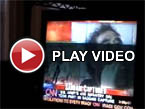Alessandro Cortini, "Forse, Volume One"
 Cortini is best known as a member of Nine Inch Nails and How to Destroy Angels, but his work with Trent Reznor is quite a bit different from this opening salvo of a planned trilogy of releases using a Buchla Music Easel as his sole instrument.  Given my justified weariness of the recent vintage synthesizer revival, it is hard to say whether I will stick with Alessandro for the entire project, yet I have to admit that his work in this field is much better than most.  In fact, the opening and closing pieces of this double album are great enough to transcend any of the limitations that I erroneously felt this genre had.
Cortini is best known as a member of Nine Inch Nails and How to Destroy Angels, but his work with Trent Reznor is quite a bit different from this opening salvo of a planned trilogy of releases using a Buchla Music Easel as his sole instrument.  Given my justified weariness of the recent vintage synthesizer revival, it is hard to say whether I will stick with Alessandro for the entire project, yet I have to admit that his work in this field is much better than most.  In fact, the opening and closing pieces of this double album are great enough to transcend any of the limitations that I erroneously felt this genre had.
In some ways, Forse ("maybe") is a reaction or counterbalance to Cortini's work with Reznor, as Alessandro found the enormous amount of tools at NIN's disposal somewhat paralyzing as a composer.  Using only the Buchla might seem like an extreme antidote to that predicament, but the idea also interested Cortini because he has come to believe that changes in how notes sound can be just as powerful as melodic or harmonic transitions.  Forse certainly gives him ample opportunity to test that theory, as he opted to record the whole album live as well, limiting his already-limited palette still further.  Given that, along with the fact that all three volumes of Forse were composed and recorded in a single month, these pieces are by necessity fairly simple experiments in exploring the potential of both the instrument and of strict self-imposed compositional constraints.
Cortini is not wrong in his belief that changes in dynamics and spectra can be hugely effective, but the catch here is that it is just about all that is changing in each piece: the Buchla does have a small keyboard, but it is impossible to get very adventurous with it while still paying close attention the various oscillator, envelope, and filter controls involved.  Cortini, to his credit, does an excellent job striking an effective balance between melodic motion and tone manipulation, yet it is still the pieces with the strongest melodies or chord progressions that stand-out.  The most striking one is the opening "Basta," which unfolds a melancholy four-chord progression in dense, glacial swells that vibrantly buzz, reverberate, and dissolve.  The similarly affecting closer, "Sera,", on the other hand, is like a muted and ghostly negative image that eventually snowballs in power to a sizzling and snarling crescendo.
All of the pieces in between are fairly varied and enjoyable in their own right, which makes for a satisfying album, but they are more "great for something played live on a Buchla Music Easel" than "great" in a more universal sense (though the throbbing, futuristic "Gira" makes a strong argument for the latter).  That is fine by me though, as two songs that wildly exceed my expectations are a lot more than most albums offer–Cortini is not a goddamn sorcerer, so there is only so much he can do with the tools at hand, no matter how talented he is.  The Buchla does sound quite spectacular though: Cortini is able to achieve a presence, density, and unpredictability with his pieces that I do not often get to hear.  They may be locked into simple patterns, but those patterns often sound huge and alive and can erupt into all kinds of roiling chaos at a whim.  I like that.  I would probably like it even more if I could get excited about vintage synthesizer forays, but I will concede that Forse is exactly the sort of album that could make someone (at least, someone less burned-out than me) excited about such things.
 



